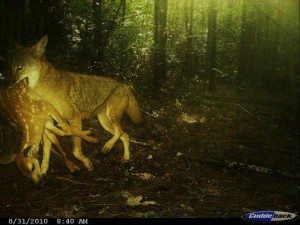 Won’t be long until the whitetail fawns start dropping, and to that end here’s some new research.
Won’t be long until the whitetail fawns start dropping, and to that end here’s some new research.
In South Carolina, researchers from Clemson University tracked the movements of 49 fawns and, separately, the movements of their mothers. Seventy percent of the fawns died before September, most of them eaten by coyotes. The 14 fawns that survived tended to have more aloof mothers who kept a greater distance from their fawns when apart, and who also visited the fawns mostly during daytime hours. The study found that does that visit their fawns at night, when coyotes are more much more active, dramatically increased their fawns’ chances of dying.





